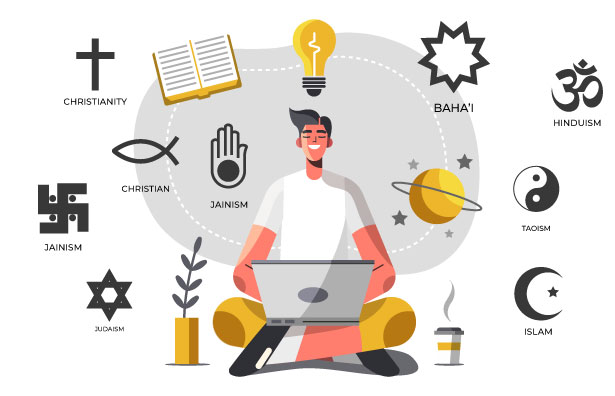Interfaith Education: Strategies for Building Interfaith Literacy and Understanding
-
by
admin
Have you ever been in a context where you sought a connection with someone from different faith but didn’t know the language or method to express it?
Or found yourself in a dilemma of liking or disliking them because of their certain religious beliefs? Nowadays, we meet people from different backgrounds, and that’s where the need for interfaith literacy and understanding comes from. Interfaith education is a way of knowing other religions’ traditions rituals, and learning to respect their individuality and uniqueness. So, let’s dive into learning some strategies for building interfaith literacy and understanding and how we can create a more connected and harmonious world!
Exposure to Diverse Religious Traditions
Of course, exposure is a poison to prejudice. To build interfaith literacy and understanding, there is a need for exposure to diverse religious traditions.
Now how can we do this?
This can be done through various means, such as attending interfaith events, visiting houses of worship of different faiths, and participating in interfaith dialogue sessions. It’s only natural to be empathetic towards fellow human beings. So, when people have the opportunity to learn about different religious traditions and interact with people of diverse faiths, they develop a soft spot for them.
Engage in Interfaith Dialogue
Another way to build interfaith literacy and understanding is by engaging in Interfaith dialogues. According to Dr Eboo Patel, interfaith dialogue is a great way to ascend differences and accept each other.
He believes that conflict can be avoided through structured dialogues or informal conversations. By engaging in interfaith dialogue, people can better understand others’ beliefs. This way, they learn to appreciate the diversity of religious traditions.
Incorporate Interfaith Education into Curriculum
In their recent study, Matthew J. Mayhew and Alyssa N. Rockenbach, incorporating interfaith education in the curriculum of schools and universities can be an important aspect of interfaith education, leading to interfaith harmony.
While studying topics on different religious traditions and interfaith dialogue in the curriculum, students can learn about different faiths. There are chances of them being engaged in meaningful conversations with people of diverse faiths. This can bring harmony among people and develop a more nuanced understanding of religious diversity.
Promote Interfaith Community Service
Interfaith community service is a great way of promoting interfaith literacy and understanding. In interfaith community services, people from different faiths work together for a communal cause.
When they work together for a common goal, they ignore the differences that separate them. People of different faiths can learn to appreciate each other’s strengths and skills and build a sense of camaraderie and understanding.
Foster Interfaith Friendships
Friendship is the most critical aspect of developing interfaith literacy and understanding. Bonnie Sue Lewis says interfaith friendships are a great source of ending hostility and prejudice among people of different faiths.
When people develop close friendships with people of different faiths, they have the opportunity to learn about different religious traditions. So, they develop a deep appreciation for the diversity of faiths. You can encourage interfaith friendships through different means. It includes attending interfaith events, participating in interfaith dialogue sessions, and engaging in interfaith community service.
Things you can do to make your faith accessible to others
If you want to bring a soft spot about your religion in people’s hearts, read scripture stories. Storytelling is an ancient way of awakening empathy, emotions and connecting. To promote interfaith literacy, scripture stories can be used to connect with other people. Many stories illustrate a theology of interfaith hospitality. These can help to promote an environment of hospitality and kindness towards strangers and other religion people.
You can explore the stories that teach ethical responsibility towards neighbours, travellers and others. These stories can promote goodness and harmony towards people of other religions.
Identify Shared Positive Values and Common Religious Practices
Identifying common values across all religions can be a great source of interfaith harmony and understanding. It can give a common ground for them to unite and connect with. For instance, all major religions have some universal attributes, such as the theology of hospitality, being kind to all creatures, and acting up to the common good. You can organise your study material around common themes such as prayer, compassion, service, or forgiveness in comparative religion courses to highlight the points of similarity.
Create Positive and Meaningful Encounters
We can only truly come to know and appreciate one another through relationships. Creating positive and meaningful encounters between people of different religions is crucial to promoting interfaith literacy and understanding. These encounters can help us better understand and appreciate the beliefs and traditions of others and can help us become more immune to misinformed religious stereotypes and destructive religious prejudice.
Conclusion
In conclusion, to build a harmonious and peaceful world, we must build interfaith literacy and understanding. The above strategies can help build an empathetic and harmonious society. It is a society where people of different faiths co-exist without much trouble. Because isn’t a diverse and inclusive world the world we all dream of?




